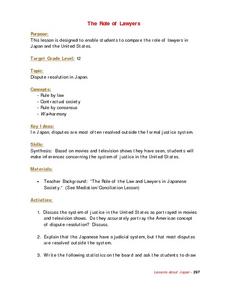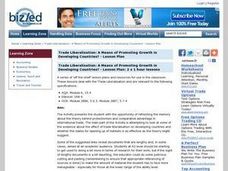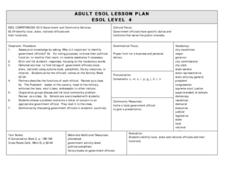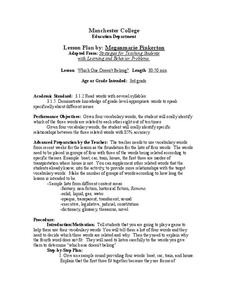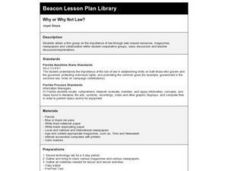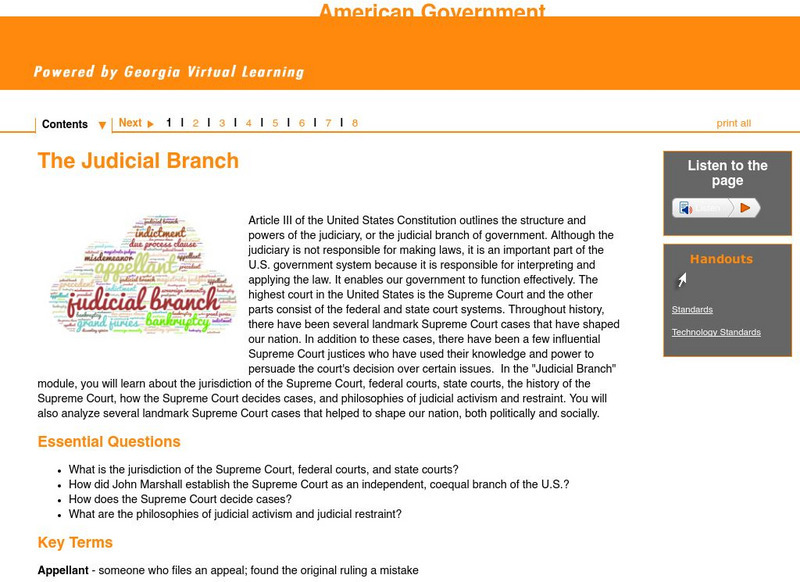Curated OER
The Role of Lawyers
Twelfth graders compare and contrast the role of lawyers in Japan and the United States. After viewing movies and television shows, they make guesses about the justice system in the United States. They answer discussion questions and...
Curated OER
George to George
Students use the internet to research the beginnings of the United States government. In groups, they examine the presidency of George Washington while they are guided along a museum tour. They end the lesson by discussing the changes...
Curated OER
US Constitution And Amendments
Pupils become familiar with the US Constitution and consider how it affects their lives. They research the Preamble to articulate the purposes of government, compile collages, and research the separation of powers within each branch of...
Curated OER
the International Criminal Court's History And Uses
Learners analyze and come to explain the history behind the formation of the International Criminal Court, along with the recent controversy facing the Court; and current crises that warrant the Court's attention.
Curated OER
Asking and Answering Questions Using the Balance of Powers
Students complete a diagram showing the relationship between the executive, legislative and judical brances of the government. They form sentences using the question words. They restate who and what questions as well.
Curated OER
Trade Liberalisation: A Means of Promoting Growth in Developing Countries?
Students draw diagrams to show the effect of tariffs and quotas on imports. They write about comparative advantage and the benefits to countries of free trade. They share their ideas with the class.
Curated OER
Dear Congressperson...
Young scholars identify their local, state, and national officials. They create a short blurb about each official and their function in office. Students choose an issue of concern they would like to write to their local official about,...
Curated OER
Which One Doesn't Belong?
Third graders identify words that are related with 80% accuracy. Given a list of four vocabulary words, 3rd graders identify specific relationships between three of the four words. They also identify which of the four words are not...
Curated OER
The Three Branches of Utah's Government
Seventh graders explain the relationship between Utah's three branches of government.
Curated OER
Order in the Court
Learners identify the branches of government, who leads each branch and its responsibilities. They understand the role that John Marshall played in our government system. They research the role of the Supreme Court.
Curated OER
Exploring the Three Branches of Government
Students view a PowerPoint presentation to explore the three branches of government. Using this infromation, they identify the people, buildings and responsiblities of each branch. They complete a worksheet using the internet and take a...
Curated OER
Bill of Rights -- Texas v. Johnson, 1989
Students examine the First Amendment of the Bill of Rights. During a visit to the George Bush Presidential Museum, they watch a video about the Texas v. Johnson flag burning case. In groups, they discover the role of the Supreme Court...
iCivics
I Civics: Mini Lesson: Judicial Activism & Restraint
Lesson teaches the judicial philosophies of activism and restraint and also explores criteria through which students can evaluate news-related opinion pieces and practice judging the value of a Supreme Court-related opinion piece of choice.
Other
Fundamentals of Judicial Philosophy: Activism
This short article discusses judicial restraint versus judicial activism, with constitutional and case study references.
iCivics
I Civics: Judicial Review
This lesson plan explores the case that established the power the Supreme Court has today. Learners will learn how the decision in Marbury v. Madison influenced the structure of the third branch, and how the Court's use of judicial...
Georgia Department of Education
Ga Virtual Learning: American Government: The Judicial Branch
Complete and comprehensive virtual learning unit on the Judicial Branch. Module includes downloads, interactive activities, questions and writing assignments as well as links to supplemental material. Students can link to online textbook...
Other
American Civil Liberties Union: Constitution Day Activities
Six activities teach students about the U.S. Constitution. Learn about checks and balances, the Bill of Rights, some of the history of the document, and how each of the states became a state. The site also provides teacher resources,...
Annenberg Foundation
Annenberg Learner: Democracy in America: The Courts: Our Rule of Law
This unit provides a comprehensive look into the value of the U.S. court system as a means to maintain the safety of American citizens. Offers video, readings, web resources, and activities.
Harry S. Truman Library and Museum
Harry S. Truman Library & Museum: Three Branches of Government
Interactive teaching unit for Grades 5-8 that helps to explain the three branches of government and the the balance of power. Topics covered include balance of government, how a bill becomes a law, the amendment process, the Legislative...
Annenberg Foundation
Annenberg Learner: Democracy in America: The Constitution: Fixed or Flexible?
This unit explores the timeless qualities of The U.S. Constitution, the opportunities to amend it, and how it is a pillar of the American identity, through these activities, videos, and outside resources.
US Government Publishing Office
Ben's Guide to u.s. Government: Grades K 2
Here you can learn all about the U.S. Government! Find information on our nation, how our government works, your own neighborhood, and the main government symbols. Games and other activities are also included!
Other
National Council for the Social Studies: Selecting Supreme Court Justices
A panel discusses the questions of whether the Senate or President hold more power in selecting Supreme Court Justices, the impact of interest groups on the process, and whether changes need to be made to the confirmation process. Along...
Annenberg Foundation
Annenberg Learner: Democracy in Action. Federalism: u.s. V. the Sates
U.S. v. the States delves into the ongoing constitutional dilemma between the federal government and individual state governments illustrated through Video on Demand, activities, readings, etc.


